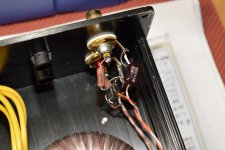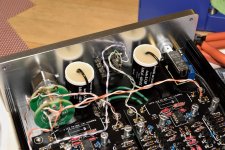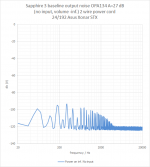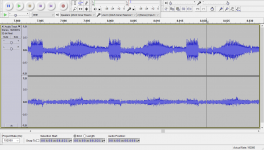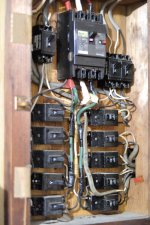Bench notes:
Put the 100 pF caps C2,3 back on the boards, sound was too raw without them.
Also added an input RC low pass filter at the RCA jacks. This is something I've been meaning to try for a while: 1nF and 1.5k ohms to cut out radio frequency hash from getting to the Sapphire boards. The 3 dB point is about 100k, so anything above 500kHz should be strongly attenuated.
The problem isn't the Sapphire per se. but rather my source, an ASUS Xonar STX soundcard... which compared to Onkyo seemed to have more "dull sheen" that I tend to associate with RFI.
With the filter, the sound is somehow more vivid and distinct so I think it is effective, though the overall difference is slight.
Put the 100 pF caps C2,3 back on the boards, sound was too raw without them.
Also added an input RC low pass filter at the RCA jacks. This is something I've been meaning to try for a while: 1nF and 1.5k ohms to cut out radio frequency hash from getting to the Sapphire boards. The 3 dB point is about 100k, so anything above 500kHz should be strongly attenuated.
The problem isn't the Sapphire per se. but rather my source, an ASUS Xonar STX soundcard... which compared to Onkyo seemed to have more "dull sheen" that I tend to associate with RFI.
With the filter, the sound is somehow more vivid and distinct so I think it is effective, though the overall difference is slight.
Attachments
The problem isn't the Sapphire per se. but rather my source, an ASUS Xonar STX soundcard... which compared to Onkyo seemed to have more "dull sheen" that I tend to associate with RFI.
The RFI is likely (assuming you've a typical PC containing a switching supply) to be common-mode noise. Normal-mode filtering helps but only slightly - use a common-mode choke (or several) or isolate with a transformer. Better still use a balanced connection to a PC but few 'consumer grade' soundcards have those, its more standard on 'pro' models.
nice one Richard 
speaking of sound cards and computers, i'm absolutely loving my little RPi coupled to the Sapphire. ok so i guess it wont set the world on fire but it has a 'boogie factor' so much so i can stop listening to it and get on with putting it all together properly. my Troidy transformers have arrived and i have those Ant regulators sitting there. hopefully by the end of February i will have it all together in a proper case.. maybe. lol
speaking of sound cards and computers, i'm absolutely loving my little RPi coupled to the Sapphire. ok so i guess it wont set the world on fire but it has a 'boogie factor' so much so i can stop listening to it and get on with putting it all together properly. my Troidy transformers have arrived and i have those Ant regulators sitting there. hopefully by the end of February i will have it all together in a proper case.. maybe. lol
Also added an input RC low pass filter at the RCA jacks.
I'm just one vote, but I would vote for RF filtering. There is a local FM radio tower/repeater about 1 mile away, line of sight. Filtering is much preferred over hearing that annoying top-10 pop rock during the quiet passages.
@abraxalito
I agree there isn't much that can be reasonably done with common mode noise when the amp is unbalanced and the input signal also. One is at the mercy of the op amp's CMRR, typically 100 dB.
It wasn't an audible as noise anyway. Just a slight greyness to the sound.
@Bibio
So yeah, those Rike caps are deliriously good. They don't have the splash/dash/sass of the Multicaps, but instead deliver organic midrange tone - together with a real sense of spaciousness and bloom. A solid kick, too, especially at higher volumes.
I agree there isn't much that can be reasonably done with common mode noise when the amp is unbalanced and the input signal also. One is at the mercy of the op amp's CMRR, typically 100 dB.
It wasn't an audible as noise anyway. Just a slight greyness to the sound.
@Bibio
So yeah, those Rike caps are deliriously good. They don't have the splash/dash/sass of the Multicaps, but instead deliver organic midrange tone - together with a real sense of spaciousness and bloom. A solid kick, too, especially at higher volumes.
I took a look at your pic of the input filtering after I'd posted and I have found that doing the filtering that way isn't particularly effective. Reason being that the screen of the cable has the CM currents on it, so running an RC right at the input socket is using a 'dirty' ground. It'll be noisier than a ground on your PCB due to those noise currents. Try the caps to GND nearer to your star point (assuming you have one).
<edit> The 'greyness to the sound' is also my experience with RF (and also power supply noise) ingress. With no audio present there's no difference (either audible or measurable) in the noise floor. Play music though and the 'smog' descends - I figure its intermodulation that's doing the damage.
<edit> The 'greyness to the sound' is also my experience with RF (and also power supply noise) ingress. With no audio present there's no difference (either audible or measurable) in the noise floor. Play music though and the 'smog' descends - I figure its intermodulation that's doing the damage.
Last edited:
I'm really only looking at attenuating differential mode noise aka trash on the signal lines. The return currents for these is back through the input cable shield, so drawing the capacitor to the star ground would only allow these currents to run around the inside of the chassis causing what havoc they may instead of being directly sent out back the way they came.
For common mode noise, my position is I'm screwed regardless by using unbalanced interconnection so I'm not going to worry about it.
For common mode noise, my position is I'm screwed regardless by using unbalanced interconnection so I'm not going to worry about it.
thats due to them being connected to a deliriously superb headamp 
IIR around 100hrs is where the magic starts to happen unless you have had them on a conditioner.
i have been through every opamp in my arsenal and i have settled on the OPA227 (haven't felt the need to swap them out), they sound pretty much like the OPA134 but dont have such a bloated lower range, kick drums have a more solid sound (most of my headphones are set up with bass in abundance so mileage may vary). for me it must sound right as i have a cheezzy grin on my face and my foot is tapping. i think one of the biggest strengths of the Sapphire MK3 is the effortless dynamic swing of being able to keep up with the music and go from quiet to loud without as much as a hint of strain, it just gets on with it.
IIR around 100hrs is where the magic starts to happen unless you have had them on a conditioner.
i have been through every opamp in my arsenal and i have settled on the OPA227 (haven't felt the need to swap them out), they sound pretty much like the OPA134 but dont have such a bloated lower range, kick drums have a more solid sound (most of my headphones are set up with bass in abundance so mileage may vary). for me it must sound right as i have a cheezzy grin on my face and my foot is tapping. i think one of the biggest strengths of the Sapphire MK3 is the effortless dynamic swing of being able to keep up with the music and go from quiet to loud without as much as a hint of strain, it just gets on with it.
The OPA227 is an improved OP27. Which is interesting as it therefore is potentially an upgrade for the Phonoclone. I tried OP27 in the Sapphire and didn't like them much, but the higher settling time of the OPA227 might be just the ticket. On paper it looks very suitable.
Notes from the bench: noise
In my house there is no earth wire. And that's a problem when you have a sapphire3 amp sharing a circuit with a computer, monitor, wifi access point and router/modem. All the switching power supplies pollute the AC line, and that RFI goes right though into the Sapphire3 amplifier and out the headphone jack.
This noise is omnipresent. It is high frequency hash modulated with some 60 Hz signal to produce overtones throughout the lower end of the audio spectrum as well as ultrasonic. Doesn't matter if the inputs are detached, or if the volume control is turned down. As long as the amp is powered up, it is there. Left channel is about 6 dB worse than right channel, likely due to the longer wiring and proximity to the AC power switch and cabling.
The level is low, below -80 dB, and it is not audible except as a subtle degradation of the perceived noise floor, but clearly for maximum performance it needs to be addressed.
1. Use shielded cable for the chassis signal wiring.
2. Shield the AC wires inside the chassis which run up to the front panel mounted power switch and back to the transformers.
3. Rig up an earth connection to the power bar by running a wire to the drain pipe.
In my house there is no earth wire. And that's a problem when you have a sapphire3 amp sharing a circuit with a computer, monitor, wifi access point and router/modem. All the switching power supplies pollute the AC line, and that RFI goes right though into the Sapphire3 amplifier and out the headphone jack.
This noise is omnipresent. It is high frequency hash modulated with some 60 Hz signal to produce overtones throughout the lower end of the audio spectrum as well as ultrasonic. Doesn't matter if the inputs are detached, or if the volume control is turned down. As long as the amp is powered up, it is there. Left channel is about 6 dB worse than right channel, likely due to the longer wiring and proximity to the AC power switch and cabling.
The level is low, below -80 dB, and it is not audible except as a subtle degradation of the perceived noise floor, but clearly for maximum performance it needs to be addressed.
1. Use shielded cable for the chassis signal wiring.
2. Shield the AC wires inside the chassis which run up to the front panel mounted power switch and back to the transformers.
3. Rig up an earth connection to the power bar by running a wire to the drain pipe.
Attachments
I find it hard to believe that this is building code compliant. Is it common in other parts of the world to have no Earth?In my house there is no earth wire.
Well, it was common in Japan until quite recently. Certainly anything built before ~1975 are just simple 2-wire. In older houses you'll most often see runs of zip cord just stapled to the wall.
For your amusement I'm attaching a photo of the main circuit break out box in my house. I'm in there fairly often, as using the toaster at the same time as the electric kettle trips the kitchen circuit. Dispite being built in the 1970's, the kitchen has no provision for a fridge. You are expected to use the pantry, under a trapdoor in the floor, or the insulated cupboard which I think was used as a small icebox.
For your amusement I'm attaching a photo of the main circuit break out box in my house. I'm in there fairly often, as using the toaster at the same time as the electric kettle trips the kitchen circuit. Dispite being built in the 1970's, the kitchen has no provision for a fridge. You are expected to use the pantry, under a trapdoor in the floor, or the insulated cupboard which I think was used as a small icebox.
Attachments
Last edited:
i just googled electricity in Japan. 100v non-polarised, 50hz in east and 60hz in west  for a country that is nutz about hifi it must be a nightmare for turntable enthusiasts.
for a country that is nutz about hifi it must be a nightmare for turntable enthusiasts.
i'm never going to moan about the electric supply in the UK again.
i'm never going to moan about the electric supply in the UK again.
Two-wire AC not yet a thing of the past
There are many houses that were built in North America, pre-WWII and into the 1950s, that had two-wire, ungrounded wiring. I lived in one myself in Houston, TX, until 1989. It was not until sometime in the 1990s that real estate title transfers in that city started to require upgraded wiring and I wonder if all jurisdictions have adopted the practice. In my home country, Canada, in older homes you can still find a mix of old two-wire and modern three-wire, and three-wire standards continue to change as new construction and renovation standards tighten in favour of safety. But in the old days (perhaps about pre 1985), universal marketability required that non-polarized power cords be fitted to audio equipment in North America, and the circuitry was designed or modified to accommodate either wire being hot. My observation has been that in the 1980s, high-end audio gear started to be offered with three-wired grounded power hook-up. The daring or ignorant would use cheater plugs to use the newer gear on old two-wire house wiring, or to manage ground-loop hum problems. My vintage two-wire equipment has been re-wired to be properly grounded, so that a component failure won't kill somebody or burn the house down. Even this is a controversial practice, as many commercial and hobbyist repair people won't contemplate altering a manufacturer's design for fear of being caught on the wrong side of liability issues. Some claim that the "collectability" and even the sound of vintage gear is impaired by fitment of polarized, grounded power connection. But if you look back far enough into early commercial radio design, not only were they ungrounded two-wire designs, but line voltage and current was used throughout the circuitry and, in my opinion, that stuff is truly dangerous, now really for nostalgic hobbyist display only.
There are many houses that were built in North America, pre-WWII and into the 1950s, that had two-wire, ungrounded wiring. I lived in one myself in Houston, TX, until 1989. It was not until sometime in the 1990s that real estate title transfers in that city started to require upgraded wiring and I wonder if all jurisdictions have adopted the practice. In my home country, Canada, in older homes you can still find a mix of old two-wire and modern three-wire, and three-wire standards continue to change as new construction and renovation standards tighten in favour of safety. But in the old days (perhaps about pre 1985), universal marketability required that non-polarized power cords be fitted to audio equipment in North America, and the circuitry was designed or modified to accommodate either wire being hot. My observation has been that in the 1980s, high-end audio gear started to be offered with three-wired grounded power hook-up. The daring or ignorant would use cheater plugs to use the newer gear on old two-wire house wiring, or to manage ground-loop hum problems. My vintage two-wire equipment has been re-wired to be properly grounded, so that a component failure won't kill somebody or burn the house down. Even this is a controversial practice, as many commercial and hobbyist repair people won't contemplate altering a manufacturer's design for fear of being caught on the wrong side of liability issues. Some claim that the "collectability" and even the sound of vintage gear is impaired by fitment of polarized, grounded power connection. But if you look back far enough into early commercial radio design, not only were they ungrounded two-wire designs, but line voltage and current was used throughout the circuitry and, in my opinion, that stuff is truly dangerous, now really for nostalgic hobbyist display only.
for a country that is nutz about hifi it must be a nightmare for turntable enthusiasts.
And people wonder why we're so big on direct-drive decks here!
To be honest the 50/60 split has very little practical impact. It was bad during the Fukushima crisis as it meant power from stations in the south of the country could not be routed up to Tokyo and more northern regions where it was needed. Outside of that, though, it mainly means you have to buy a new microwave if you move.
There are many houses that were built in North America, pre-WWII and into the 1950s, that had two-wire, ungrounded wiring.
The issues don't stop there - the autotransformers in the American style grid that split the 200 to 100+100 (or 110 or 120 depending on which adoption it is) actually have a frequency dependent transfer characteristic - grid surges and other anomalies can be amplified when they pass onto the 100V lines instead of attenuated.
If you're living in a first world country with 230V/400V power you really shouldn't have anything to complain about (unless you're serviced by SWER
i just googled electricity in Japan. 100v non-polarised, 50hz in east and 60hz in westfor a country that is nutz about hifi it must be a nightmare for turntable enthusiasts.
i'm never going to moan about the electric supply in the UK again.
I think the UK is in good shape with electrical safety. I always thought the fused plugs were overkill.
- Home
- Amplifiers
- Headphone Systems
- RJM Audio Sapphire Desktop Headphone Amplifier
